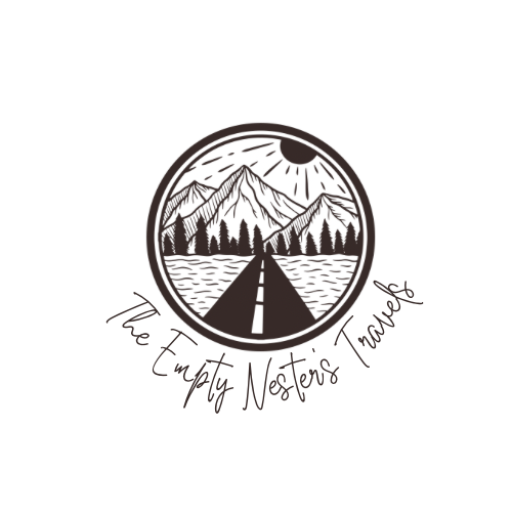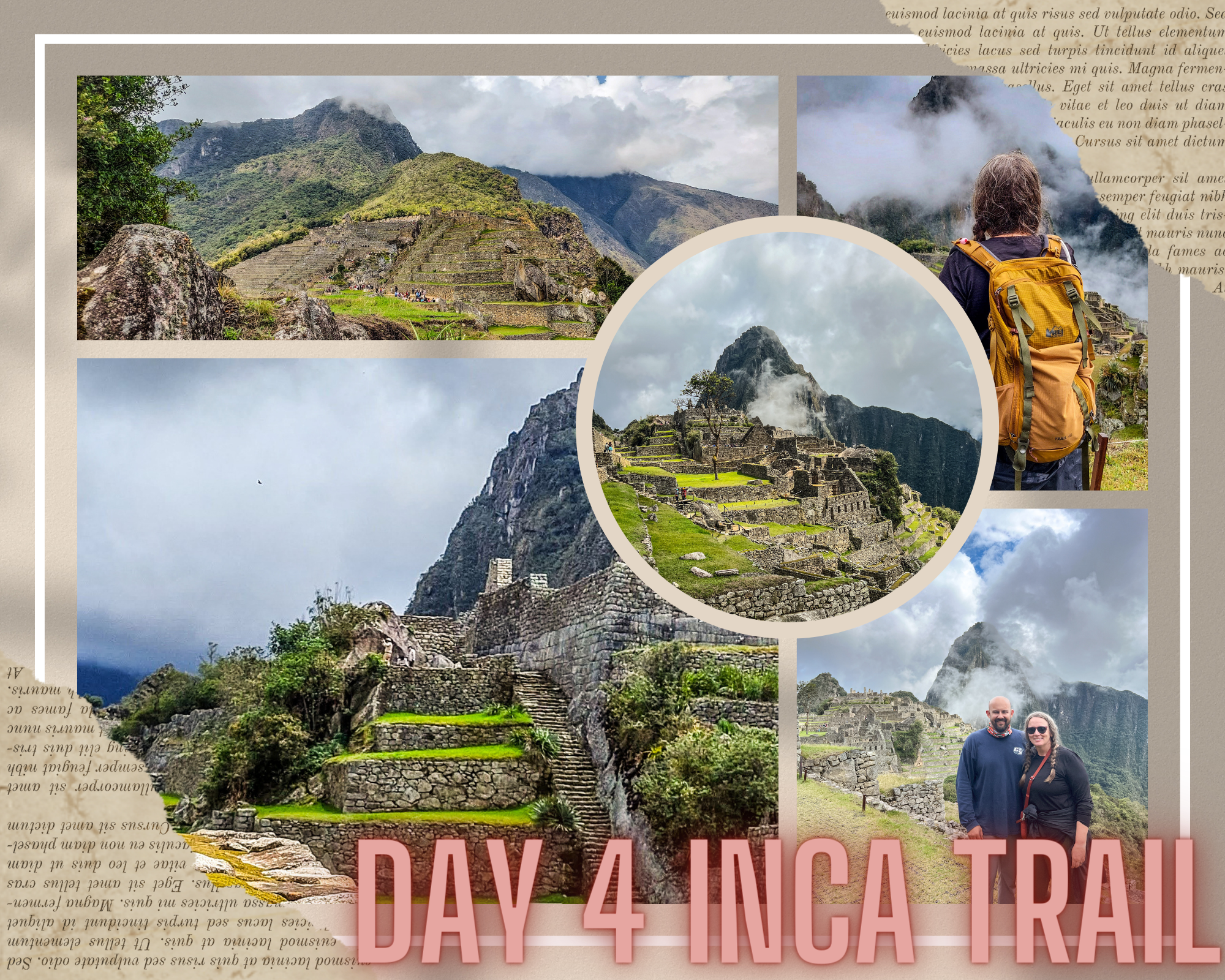Wiñaywayna – Machu Picchu (3h for 6km with 90 m/295 ft elevation gain)
The final day of the Inca Trail hike started pre-dawn at 0315 to reach the check point and then the Sun Gate as early as possible. We headed to the checkpoint (a quick 10 minute walk) and joined the queue to wait for the gate to open. The line of fellow pilgrims at the gate reflected the shared reverence and excitement that pulsed through the cool morning air. Each heart held a dream of witnessing the first sun rays illuminate the mystical ruins of Machu Picchu.
We had to climb up the “monkey steps” to arrive at the sun gate. Our first views of the Machu Picchu were that covered in fog and clouds.







We waited at the sun gate for a little while hoping for the skies to clear, but to no avail, we hiked down to Machu Picchu.
We were able to take plenty of time to take photos before we exited the ruins in order to drop bags, use the restroom, and for those coffee mongrels to get their caffeine fix they had been longing for. Once everyone had regrouped, we re-entered Machu Picchu for our tour of the ruins.








Our guided sojourn through the hallowed grounds of Machu Picchu commenced under the soft glow of the morning sun. The gentle narrative of our guide took us on a voyage through time as we meandered through the sacred precincts of the ancient city. The insights into the enigmatic Inti Mach’ay cave, the celestial Inti Watana, the cleansing Temple of the Water, the majestic Temple of the Condor, and the mystical Room of the Three Windows were not just revelations of an architectural marvel but an odyssey into a civilization’s profound communion with nature and cosmos.











The leisurely pace of our exploration allowed us to soak in the essence of this 15th-century marvel. The hushed whispers of the past resonated through the sacred grounds as we sat amidst the ruins, the energy of Machu Picchu enveloping us in a tender embrace. The site, a cherished UNESCO World Heritage entity and a proud gem among the new Seven Wonders of the World, seemed to resonate with the collective reverence of humanity towards the mysterious and the divine.
The moments of silence amidst the ruins were a dialogue between the past and present, an ode to the celestial and earthly mysteries that cradled this ancient city. As we cast our final glances upon Machu Picchu, the soft murmurs of the Urubamba River below seemed to carry with them our deepest reverences and memories into the heart of the Andes, sealing within us an odyssey of spirit and stone that would resonate through the annals of our lives.
Machu Picchu History Lesson
Perched amidst the Andean mountain range of modern-day Peru, the breathtaking ruins of Machu Picchu continue to captivate the imaginations of travelers, historians, and archaeologists alike. Often referred to as the “Lost City of the Incas,” this UNESCO World Heritage site remains one of the most iconic symbols of Inca civilization. What makes Machu Picchu so special, and why did the Incas build this extraordinary settlement in such an inaccessible location?
Discovery: A “Lost City” Revealed
Though local farmers were aware of its existence, Machu Picchu gained worldwide attention only in 1911 when American historian and explorer Hiram Bingham III rediscovered the site. Financed by Yale University and the National Geographic Society, Bingham undertook multiple expeditions that unearthed artifacts and gained valuable insights into Inca culture. His efforts brought Machu Picchu into the global spotlight, inspiring countless studies and journeys to the site.
Historical Background and Significance to the Incas
Machu Picchu, whose name means “Old Mountain” in Quechua, is believed to have been built in the 15th century under the reign of the Inca emperor Pachacuti. However, its exact purpose remains a subject of scholarly debate. Some theories propose that it was a royal estate or a religious retreat, while others suggest it could have been an astronomical observatory.
Royal Retreat or Sacred Sanctuary?
The site’s architecture and layout indicate an advanced understanding of astronomy, agriculture, and urban planning. Exquisite stonework is evident in buildings like the Temple of the Sun, a round tower that aligns with the sun during the summer solstice. The intricacy and purposefulness in the design suggest that Machu Picchu was more than a mere residential complex; it likely held spiritual or ceremonial significance.
Inaccessibility and Preservation
One of the most compelling aspects of Machu Picchu is its strategic location. Perched at around 2,430 meters (7,970 feet) above sea level, the site is virtually concealed from below and is accessible only through narrow paths, including the renowned Inca Trail. This inaccessibility might have contributed to its preservation, making it one of the most well-preserved Inca sites and allowing it to escape destruction during the Spanish conquest.
Agriculture and Sustainability
Terraced fields surround the main structures, underlining the importance of agriculture for the self-sufficiency of this isolated community. These terraces not only provided essential crops but also acted as a drainage system that protected the city from flooding.
Machu Picchu Today
Today, Machu Picchu stands as one of the most visited tourist attractions in the world, drawing people from various walks of life. Though commercialization poses challenges to its preservation, strict regulations aim to minimize human impact and safeguard its historical and cultural integrity. Those who journey to this ancient site often describe their experience as transcendent, a tribute to the advanced civilization that once thrived there.
Machu Picchu continues to be an enigma that invites exploration and interpretation. Whether it served as a royal retreat, a sacred sanctuary, or a combination of both, its intricate design and stunning location attest to the ingenuity of the Incas. As you wander through its stone pathways or stand in awe beneath its towering peaks, you’re not just experiencing a relic from the past—you’re connecting with an ancient civilization that, despite its disappearance, has left an indelible imprint on the world.
Return to Cusco
We caught the bus outside the Machu Picchu gate after our visit for a 25-min downhill ride to Aguas Calientes. We ate, celebrated Efrain’s and Nikki’s birthday and then relaxed before the train ride.


We caught the train back to Ollantaytambo (2-3 hr 118 km). Time to climb aboard, take a seat, and enjoy the ride. We were all quite excited for the completion on the trek. Our excitement bubbled over and we had a few complaints on being too loud from fellow train riders, but we couldn’t contain ourselves!
Next private bus back to Cusco (2 -2 1/2 hr 95 km). We settled in and enjoyed the scenery. We welcomed a cozy bed and hot shower to wash away the woes of the days on the trail
So go ahead, make that pilgrimage to the heart of the Andean mountains, and let the magic and mystery of Machu Picchu sweep you off your feet.
-S&E



Embarking on the Journey of a Lifetime: The 4-Day Inca Trail Hike to Machu Picchu | The Empty Nesters’ Travels
Monday 23rd of October 2023
[…] Day 4: Arrival at Machu Picchu […]